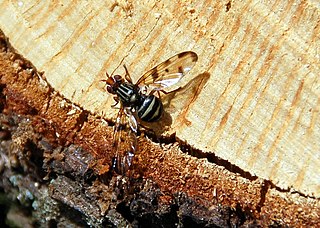
The Ulidiidae or picture-winged flies are a large and diverse cosmopolitan family of flies (Diptera), and as in related families, most species are herbivorous or detritivorous. They are often known as picture-winged flies, along with members of other families in the superfamily Tephritoidea that have patterns of bands or spots on the wings. Some species share with the Tephritidae an unusual elongated posteroapical projection of the anal cell in the wing, but can be differentiated by the smoothly curving subcostal vein. Two species, Tetanops myopaeformis and Euxesta stigmatias, are agricultural pests.

The Streblidae are a family of flies in the superfamily Hippoboscoidea, and together with their relatives the Nycteribiidae, are known as bat flies. They are winged or wingless ectoparasites of bats, and often have long legs. They appear to be host-specific, with different species of bat flies occurring only on particular species of bat hosts, sometimes with multiple species of flies sharing a host bat.

Odiniidae is a small family of flies. There are only 58 described species but there are representatives in all the major biogeographic realms.

Daniel William Coquillett was an American entomologist who specialised in Diptera. He wrote a revision of the dipterous family Therevidae and many other scientific papers in which he described many new species and genera of Diptera. Coquillett was also the first to attempt fumigation with hydrocyanic acid as a means for controlling citrus scale insects. He experimented in the Wolfskill orange groves where he was supported by the foreman and later quarantine entomologist Alexander Craw in 1888–89.

The Richardiidae are a family of Diptera in the superfamily Tephritoidea.
Ateloglossa is a genus of bristle flies in the family Tachinidae. There are about 14 described species in Ateloglossa.
Euxesta willistoni is a species of ulidiid or picture-winged fly in the genus Euxesta of the family Tephritidae. It was described by Daniel William Coquillett in 1900.

Paroedopa punctigera is a species of ulidiid or picture-winged fly in the genus Paroedopa of the family Ulidiidae.

The Pediciidae or hairy-eyed craneflies are a family of flies closely related to true crane flies, with about 500 species worldwide.

Otitinae is the name of a subfamily of flies in the family Ulidiidae. It was formerly the Otitidae. Like the Ulidiinae, most species are herbivorous or saprophagous. Most species share with the Tephritidae an unusual elongated projection of the anal cell in the wing, but can be differentiated by the smoothly curving subcostal vein. Most are dull gray to shiny brown or black flies with vein R1 setulose or, in a few cases, bare.

Nostima is a genus of shore flies in the family Ephydridae.
Chasmatonotus is a genus of midges in the family Chironomidae. There are about 14 described species in Chasmatonotus.

Myennidini is a tribe of picture-winged flies in the family Ulidiidae.

Ilytheinae is a subfamily of shore flies in the family Ephydridae.
Cirrula is a genus of North American shore flies in the family Ephydridae.
Leptopsilopa is a genus of shore flies in the family Ephydridae.
Myiomyrmica is a genus of picture-winged flies in the family Ulidiidae.
Amphicnephes is a genus of signal flies in the family Platystomatidae. There are at least three described species in Amphicnephes.

Microphor is a genus of flies in the family Dolichopodidae, subfamily Microphorinae.











